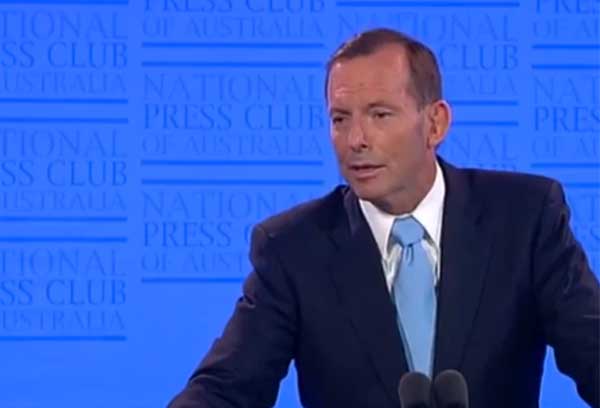One hundred years ago this May, the passenger liner Lusitania was torpedoed off the coast of Ireland by the German submarine U-20. A total of 1,198 lives were lost, many of them innocent citizens from neutral America.
The atrocity outraged international sentiment and helped turn American opinion against Germany. It played a central role in the decision of the United States to enter the Great War two years later.
The fate of the Lusitania is a salient reminder of the chief role that submarines have always played in war: the sinking of merchant ships and the killing of innocent civilians.
It’s a reminder the Abbott government would do well to reflect upon this week, as it struggles with an underwater menace of its own.
In a week in which the Prime Minister only narrowly escaped an ignominious downfall, it’s somewhat surprising that a fleet of unbuilt submarines has come to occupy so much of the government’s attention.
But that’s the nature of politics in 2015, when long-term decisions about the future of the Royal Australian Navy have suddenly coincided with the ongoing crisis in the Prime Minister’s Office. All of a sudden, a $30 billion defence acquisition has become a pawn in the numbers game to save Tony Abbott’s career.

How? Abbott used the subs to shore up his party support. The embattled PM promised South Australian Liberals that he would commit the government to allowing Australian companies to tender for the job of building Australia’s new submarine fleet in Adelaide.
We know this because one of those South Australian Liberals told us. Senator Sean Edwards announced on Monday that the deal had been done.
“This is significant news for South Australia: that a full and open tender process will be the Government's policy from here on out,” Edwards told ABC radio. “And I'm delighted and I must say I'm greatly relieved."
The government has been on the back foot ever since. On Tuesday, for instance, Abbott sent Defence Minister Kevin Andrews to Adelaide to try and hose down the controversy.
Except Andrews just confused matters. There wasn’t going to be a tender. There was going to be a “competitive evaluation process.”

Now, some would say the Liberal Party knows a thing or two about competitive evaluation processes, having just voted on one for Tony Abbott on Monday. But exactly what the phrase means for the shipyards of Adelaide is anyone’s guess.
What we do know is that it’s caused plenty of disquiet in Liberal ranks. Assistant Infrastructure Minister Jamie Briggs is reported to have blown his top at the hapless Edwards, after he proved utterly unable to explain what the Prime Minister told him.
Meanwhile, the Prime Minister was yesterday making bewildering references to “Kim Jong-Il-class submarines” – whatever that means.
The murky waters of the submarine debate shows just how divided and disorganized the government is just now. It mirrors the confusion the government demonstrates in so many other policy areas – from health, where we still don’t know what’s happening with the GP co-payments, to the budget, where Joe Hockey and Tony Abbott seem to be saying completely different things about tax cuts and the deficit.
Ironically, the crash dive on submarine policy has prevented us from having the debate voters deserve about submarine construction: whether we need new subs at all.
Regular readers of New Matilda will know that we have long questioned the value of building a new fleet of submarines. Their role in any future war will almost certainly be to attack civilian shipping, rather than to defend the Australian homeland.
But the admirals in Canberra remain utterly committed to the idea of new submarines, first announced in Kevin Rudd’s 2009 Defence White Paper. With precious little real debate, both major parties have committed to the idea of 12 new submarines – double our current number.
Cost estimates for the new boats range from somewhere above $20 billion to somewhere below $40 billion. They will be the single most expensive purchase the Australian government has ever bought.
The eye-watering sticker shock for the boats has tied politicians and defence planners in knots, ever since Kevin Rudd first announced them. But, rather than debate whether we should build them at all, most of the discussion has centred around where they should be built, and who we should buy them from.
There are plenty of shipyards around the world that can build modern submarines. The Germans have a submarine they would like to sell us. The French have a sub. So does Japan. And, of course, Australia could also build a sub at the Australian Submarine Corporation’s dry-dock in Adelaide.
Quite understandably, South Australia would like any subs to be built and maintained in Adelaide. What state wouldn’t welcome $30-odd billion in new investment?
The problem with the Australian option is that many defence experts think it will be more expensive. Tens of billions more expensive.
The Australian Defence Force has a woeful record in defence acquisitions. They regularly run late and over-budget. Our current fleet of subs, the Collins class boats (PICTURED BELOW), are said to be very quiet and dangerous. They also ran years late and have a disastrous maintenance record. Infamously, HMAS Farncomb nearly sank in 2011.

Australia doesn’t build most of the weapons our armed forces use. We buy them from other countries, generally the United States. This process has been given the entirely misleading phrase “military off the shelf”, as though defence ministers go shopping at Lockheed Martin and come back with tote bags full of Joint Strike Fighters.
In truth, “military off the shelf” is one of the great cons of the defence debate, as the submarine controversy shows. A true “off the shelf” purchase would simply buy a weapon already in production with another country, as Brendan Nelson did in 2006 when he bought two squadrons of Super Hornet jets from Boeing.
Very few of Australia’s defence purchases have been “off the shelf”. The Air Force or Navy always want to add extra options and capabilities. In the most notorious case, the Navy tried to buy and modify Super Seasprite helicopters. The acquisition turned out so badly, it had to be cancelled.
Or take the example of our new destroyers. We bought the design from a Spanish firm, Navantia. But we got an entirely different consortium, headed by the Australian Submarine Corporation, to build them.
The destroyers are running three years late and hundreds of millions over budget. This was what prompted former Defence Minister David Johnston to complain that the ASC “couldn’t build a canoe” – a remark that cost him his job.
The submarines won’t be off the shelf either. They can’t be: the Navy wants big, long-ranging subs that can travel thousands of nautical miles in a single mission. It also wants to use American sonar technology, even if they are not American boats. So we’re back to the risky challenge of combining different technologies in what will inevitably be a brand new design.
This doesn’t seem to have worried Tony Abbott. If the rumours are true, he and Japanese Prime Minister Shinzo Abe agreed on a deal to buy Japanese subs last year. But the government denied this today
So where does the government stand on submarines? No-one knows, and the government can’t explain.
No wonder confusion reigns. Whatever the Prime Minister’s claims that “good government starts today,” in defence, as in health and fiscal policy, the government is all at sea.
Donate To New Matilda
New Matilda is a small, independent media outlet. We survive through reader contributions, and never losing a lawsuit. If you got something from this article, giving something back helps us to continue speaking truth to power. Every little bit counts.



